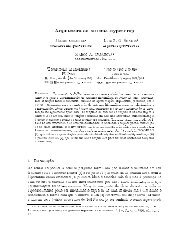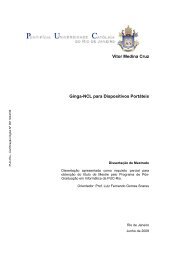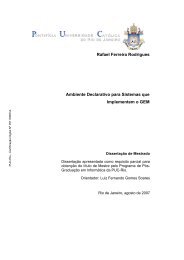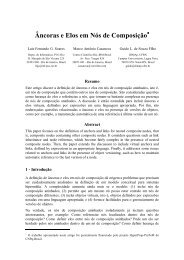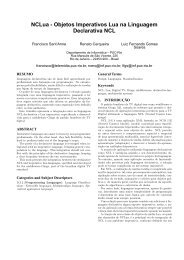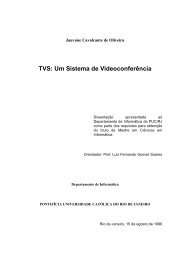Ginga-NCL: Declarative Middleware for Multimedia IPTV Services
Ginga-NCL: Declarative Middleware for Multimedia IPTV Services
Ginga-NCL: Declarative Middleware for Multimedia IPTV Services
Create successful ePaper yourself
Turn your PDF publications into a flip-book with our unique Google optimized e-Paper software.
78<br />
elements, and shall be defined<br />
as a child element of the element. Transition<br />
effects can be applied at the beginning or<br />
end of a media object presentation, as defined in<br />
attributes of the element associated<br />
with the media object.<br />
In order to illustrate an <strong>NCL</strong> use case,<br />
assume the following simple application: during<br />
a soccer game animation, an advertisement, temporally<br />
related with a special scene of the animation,<br />
is presented, allowing a viewer to interact<br />
to buy the product (soccer shoes). In order to<br />
avoid annoying other viewers, the interaction<br />
processes will not be exhibited on the TV screen,<br />
but on secondary device screens, <strong>for</strong> example,<br />
mobile phones. Figure 2 illustrates this application.<br />
The complete <strong>NCL</strong> code is presented in<br />
Fig. 3.<br />
In Fig. 3, lines 5 to 9 define two regions in<br />
the base device (the TV set). The “main-<br />
ScreenRg” region occupies the whole display<br />
and the “iconRg” region (with zIndex=“1”)<br />
overlays the previous region (default zIndex=“0”)<br />
in the bottom right corner of the<br />
1: <br />
2: <br />
4: <br />
5: <br />
6: <br />
7: <br />
9: <br />
10: <br />
11: <br />
12: <br />
13: <br />
14: <br />
15: <br />
17: <br />
18: <br />
19: <br />
20: <br />
21: <br />
22: <br />
23: <br />
24: <br />
25: <br />
26: <br />
27: <br />
28: <br />
29: <br />
30: <br />
31: <br />
32: <br />
33: <br />
35: <br />
36: <br />
37: <br />
39: <br />
41: <br />
42: <br />
44: <br />
45: <br />
46: <br />
47: <br />
48: <br />
49: <br />
50: <br />
51: <br />
52: <br />
Figure 3. <strong>NCL</strong> application code.<br />
device screen. Lines 10 to 12 define the<br />
“advertRg” region as filling the whole “systemScreen(2)”<br />
secondary display. Lines 13 to<br />
18 define the descriptor base, whose<br />
elements define in which region<br />
each related media object will be exhibited. The<br />
“iconDs” descriptor also specifies the explicit<br />
duration of 40 s <strong>for</strong> the icon exhibition.<br />
Lines 19 to 29 define the connector base. The<br />
causal connector “onBeginStart” has its condition<br />
satisfied when a media object’s anchor<br />
starts its presentation, triggering, as a result, the<br />
starting presentation action on another media<br />
object’s anchor. The causal connector “onKey<br />
SelectionStart” specifies that the selection<br />
of a media object’s anchor, by pressing a key,<br />
triggers the starting presentation action on<br />
another media object’s anchor.<br />
The element defines the document<br />
structure. The port in line 32 states from which<br />
media object the document presentation initiates<br />
(in this case, the “video” media object). The<br />
“video” media object (lines 33 to 36) is<br />
received from<br />
“rtp://www.ginga.org.br/video.<br />
mp4” to be presented in full screen, as defined<br />
by its descriptor. The “icon” is an imperative<br />
media-object with Lua code, implementing a<br />
blinking soccer shoes image. The “advert”<br />
media object (lines 39 and 40) is an XHTML<br />
content to be presented on secondary devices.<br />
Lines 41 to 45 define the first relationship,<br />
stating that the “icon” media object must start<br />
its exhibition as soon as the “iconA” temporal<br />
anchor of the “video” media object begins its<br />
presentation. Lines 46 to 50 specify another relationship,<br />
establishing that a viewer interaction<br />
with the “icon” image pressing the remote<br />
control RED key must start “advert” media<br />
object presentation (a purchase web page) on<br />
secondary devices.<br />
The Lua code that carries out the soccer<br />
shoes animation is presented in Fig. 4.<br />
The isON and stop flags (line 1) control<br />
when the soccer shoes icon is presented and<br />
when the animation stops, respectively. The<br />
function myBlinkAnimation is used to<br />
redraw the canvas, per<strong>for</strong>ming the blink effect<br />
on the icon. The function starts getting the canvas<br />
size (line 3), draws a rectangle filling the<br />
canvas (line 4), and then combines the soccer<br />
shoes image with the canvas, depending on the<br />
isON flag value (lines 5 to 7). Line 8 updates<br />
the isON flag, and line 9 calls the canvas flush,<br />
in order to update the screen. Line 10 calls<br />
myBlinkAnimation every 1000 ms, while<br />
stop flag is true.<br />
The <strong>NCL</strong>ua API defines an event-oriented<br />
communication between <strong>NCL</strong> and Lua codes.<br />
When the Lua object is started, line 18 registers<br />
an event handler <strong>for</strong> the stop presentation event<br />
to be received from <strong>NCL</strong>, and starts the blinking<br />
animation (line 19), calling the myBlinkAnimation<br />
function. When an <strong>NCL</strong> link stops the<br />
Lua object, a “stop” event is received and<br />
treated by lines 13 to 16.<br />
THE GINGA-<strong>NCL</strong> ARCHITECTURE<br />
<strong>Ginga</strong>-<strong>NCL</strong> was initially proposed <strong>for</strong> terrestrial<br />
IEEE Communications Magazine • June 2010



